Optimizing customer experience means understanding users.
Fundamentals
Author: Julia Borkenhagen, CXO and Co-founder at Whitespace
Date: 21 July 2016
Optimizing customer experience means making changes to a product or service in order to improve the way it is used by customers. In order to do this effectively, it is important to understand the needs, preferences, and behaviors of the users. This is because different users may have different requirements and expectations, and what works well for one user may not necessarily work well for another.
By understanding the users, it is possible to identify the key issues and areas for improvement and to tailor the product or service to better meet the needs of the target audience. This can help to increase customer satisfaction and loyalty, leading to long-term success for the business.
Customer experience (CX) remains a top priority for online businesses
What emerged as a trend in 2014 is now a strategic mandate for E-Commerce managers. According to a recent survey by eConsultancy and Adobe, companies and agencies rank “Optimising the customer experience” at the top of the list of exciting opportunities for 2016, well above other headline topics such as cross-channel marketing, social marketing, or the Internet of Things.
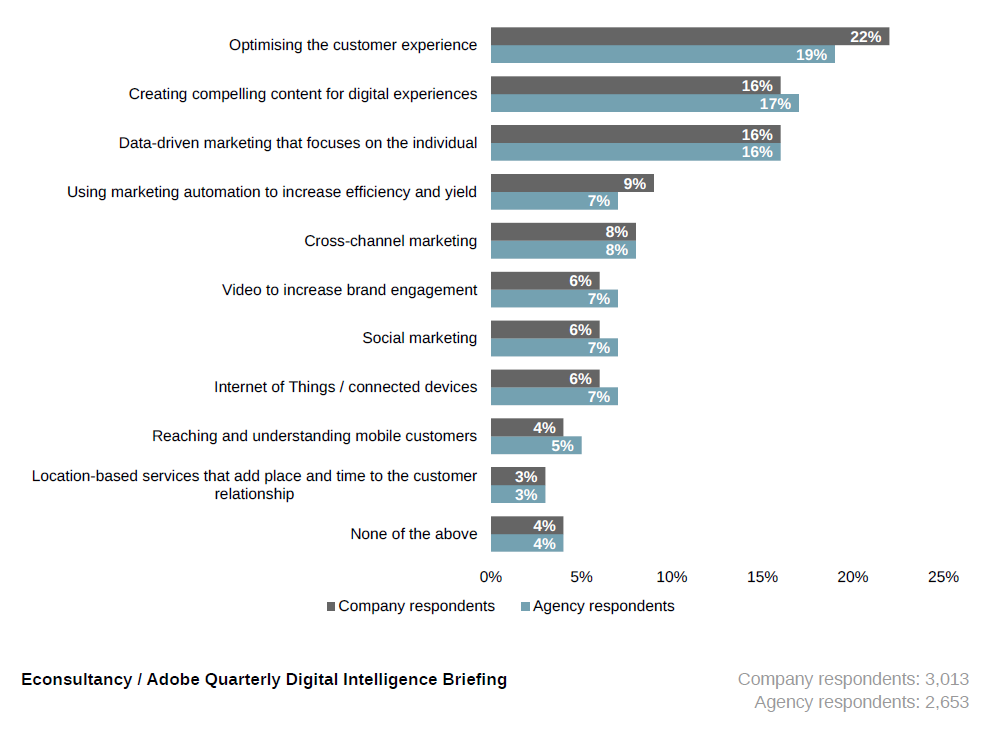
As a user experience (UX) practitioner, I am delighted to see so much attention bestowed on customers. Without trying to open a semantic can of worms, suffice it to say that in the online world, your customers are also your users. (See more about UX vs CX here.)
So before you set out to optimise the experience of your E-Commerce storefront, I feel it’s important to take a moment to consider why people shop online, how they behave with a mouse or touchscreen in their hand, and who they actually are.
In this article, I offer some observations and guidelines to help stimulate your analytical and creative thinking as you embark on the customer experience journey.
Why do people shop online?
In Europe, 43% of the population over age 15 shops online, spending an average of EUR 1,540 per person per year. In the US, the numbers are higher, with 67% online shoppers spending USD 3,428 per person in 2015. (Source: European B2C E-commerce Report 2016, Ecommerce Foundation)
The numbers have grown steadily over the years, and the share of mobile in online sales – 20% for the US market in 2015 – has grown as well. The question is: Why? What, for instance, motivates people to buy shoes, of all things, online?
Surprisingly, finding the lowest price is not the top of the list. Different studies all seem to point at convenience as the primary motivating factor. A Swiss study by Netcomm Suisse in 2016 identifies “saving time” and “shopping at any time” as the two top factors, followed by the benefit of having a large choice of products and finding what you’re looking for more easily.
The four main reasons for shopping online are:
- Convenience: Unless someone is a brick-and-mortar shopaholic, people enjoy the convenience of shopping from home, on the road, any time, any day or night. This is especially true before the holidays.
- Choice: People find a larger selection of products than in the offline world. The “long tail” products (niche products with low demand) can be more easily found online and variety is usually greater.
- Price: People expect a better price online than offline (or at least the equivalent). Typically for larger purchases, users will visit a store, touch it or try it out, then google on their phone to compare the price. If the online price beats the offline one, they will generally take their business online.
- Knowledge: Consumers can often obtain more information about the product and the company via detailed product descriptions, video demonstrations, and customer feedback than they would from an in-store salesperson. If shoppers have additional questions, many online stores offer live chat features that put people in direct contact with customer service agents.
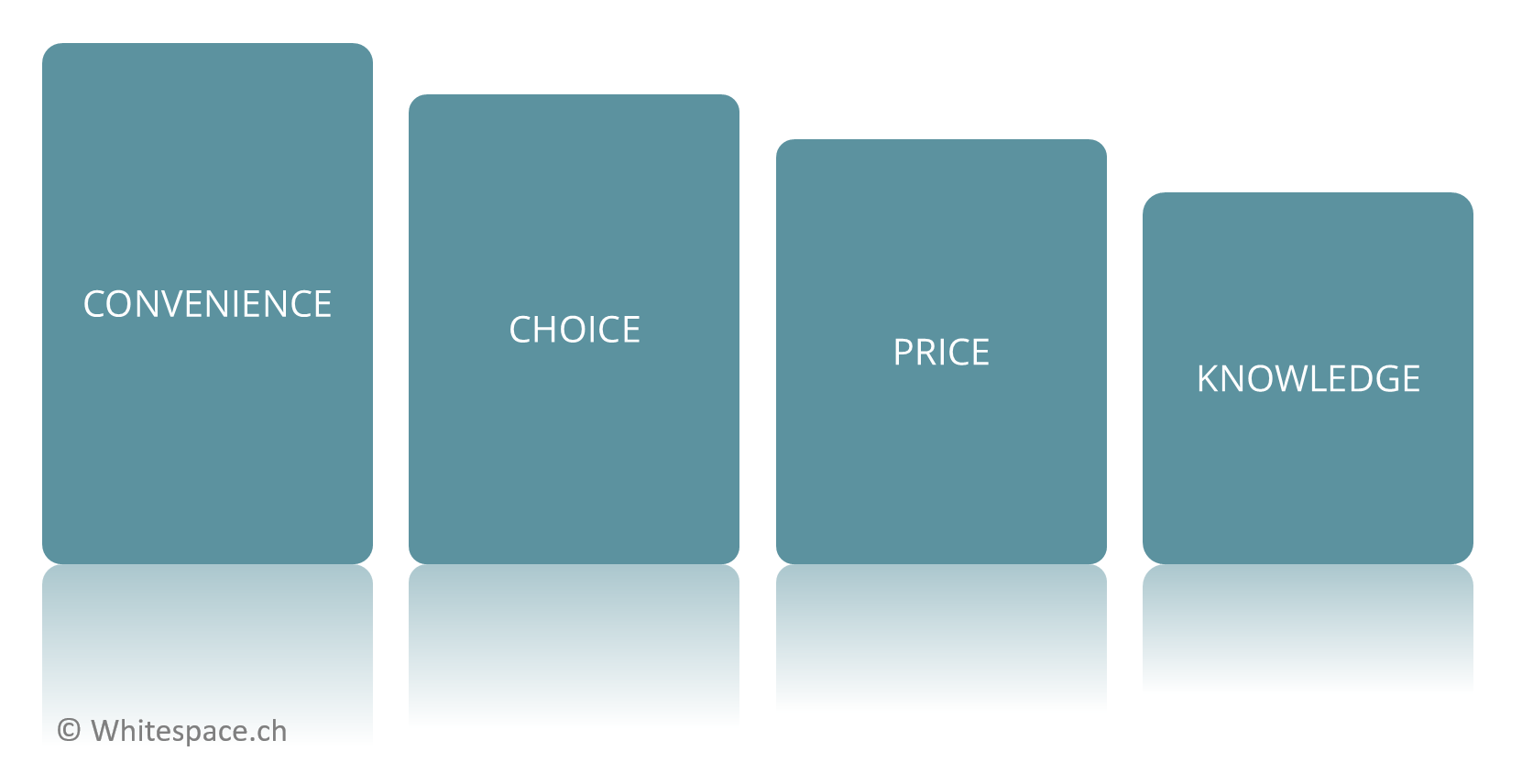
It is also interesting to look at why someone may not shop online. The same Swiss study showed that the most important reason not to shop online was to want to check the quality of the product in person and get the advice of a trusted vendor (42%). Shipping costs came in second at 29%, followed by lack of trust in online payment methods.
How do people shop online?
The why part is relatively clear, but when it comes to how people shop online, things get a little messier.
It’s no secret: the traditional sales funnel is dead.
The truth is that shoppers do not pursue a linear path when shopping. Instead they will often navigate in circles: going in and out of detailed product pages, looking for comparisons, searching other sites, using different devices. The shopping cart becomes a kind of virtual changing room – a holding place like the wheel in the illustration, not the end of the purchase process.
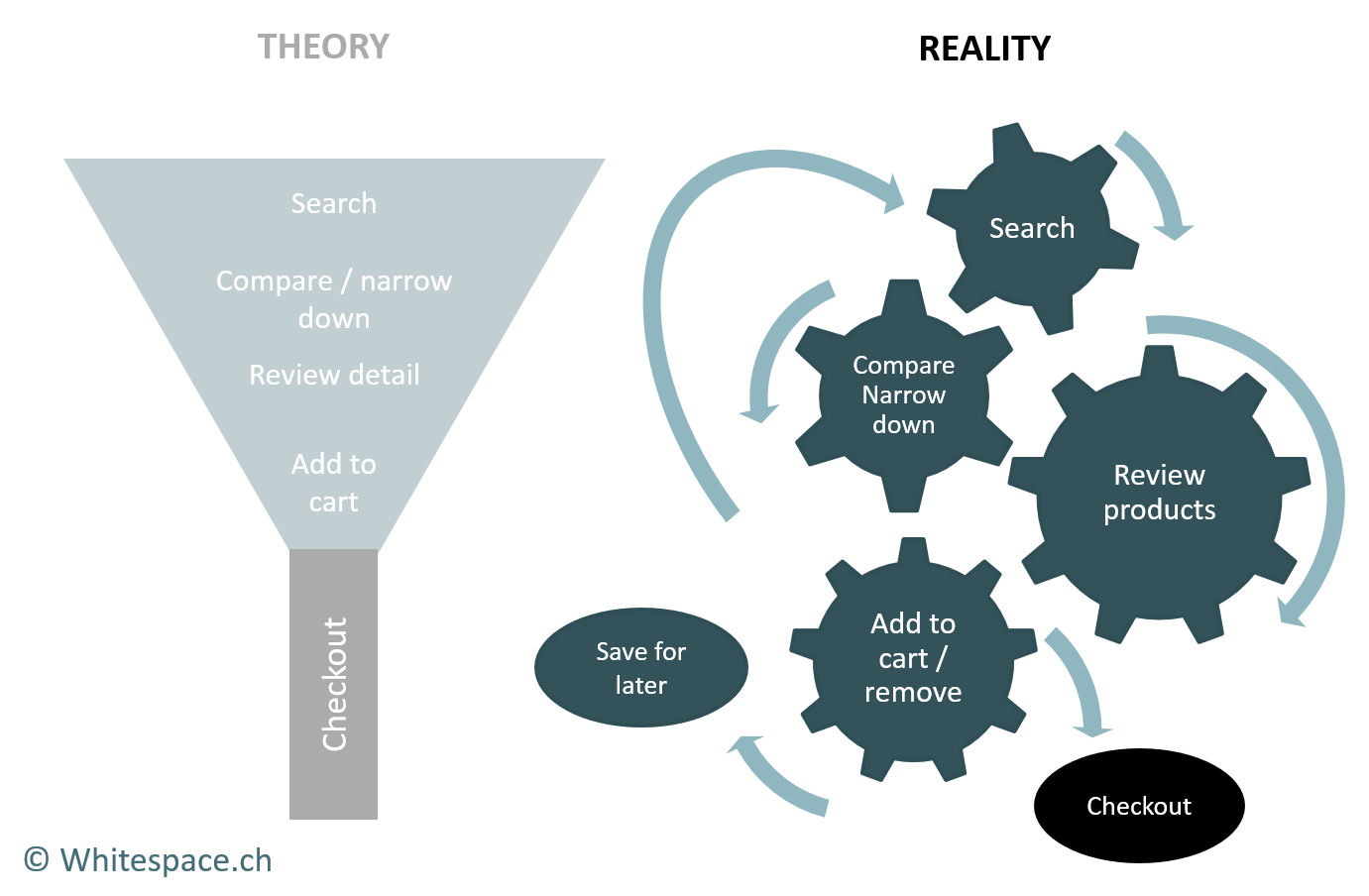
When designing the E-Commerce experience, it is important to understand this circular behavior by making sure the navigation allows for non-linear movement and that the site provides “stop-and-start” features, such as wish lists, saved shopping carts, offline pickup options, product comparisons, recommendations, and more.
The omni-channel customer journey
On top of it, users tend to pursue their shopping across different channels, offline and online, on different devices. While desktop purchases still beat mobile ones, users tend to start their research on mobile, especially when on the go and in a store.
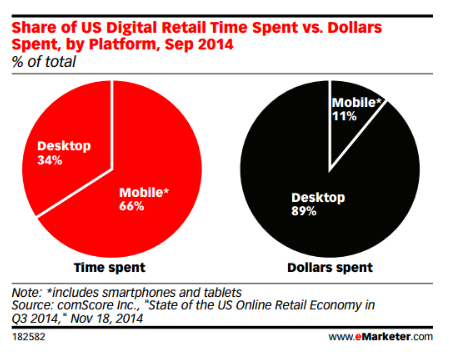
Lately, so-called omni-channel strategies are top of mind for marketing departments. One of the first companies to implement a comprehensive program of this kind was Best Buy, who listened to their customers and basically turned their stores into warehouses. Users were able to research and buy online, then collect the product at the nearest point of sale. Best Buy also ensured that their customers would have the same prices regardless the channel and that all available customer information is used to offer a personalised and relevant experience. (More on this example and omni-channel strategy in this article published by Strategy&, a pwc company.) This hybrid, user-centric model has been emulated by a number of retailers worldwide, including sporting goods store Décathlon in France.
What kinds of users are we dealing with?
User segmentation can help when deciding which content or features to prioritize. While there are many approaches to categorizing your customers, two helpful methods include user archetypes and demographic profiling.
User mindsets vary from person to person and can even alter for the same individual under different circumstances. Depending on where shoppers are in the purchase process, they will be looking for different information and resources. The trick is to strike the right balance for the site to answer the needs of its specific user base. Indeed, each online store may also have a very specific mix of various user archetypes:
- The browser and explorer
Intuitive navigation and search functions are important. Related items, stories, and detailed product information are helpful. - The “I know what I want” purchaser
In and out – speed, convenience, and efficiency are key. - The researcher and comparison shopper
This shopper wants to compare features and prices. He or she also values the opinions of previous buyers. - The bargain hunter
Coupons, promotions, and last-minute offers are on this shopper’s radar screen. - The loyal / repeat customer
This customer needs time-saving functionality such as quick-order forms or one-click purchases, as well as special value programs and loyalty offers. - The one-time shopper
Granted, unless you’re Amazon, you may have a few one-timers. It’s important not to scare them off with complicated registration procedures. Instead, “buy as guest” options and clear return policies are useful. - The novice (aka virgin) shopper
An inexperienced online shopper may need additional “how to” information and appreciate tools that help guide them through the selection and purchase processes. Security assurance in form of a trust badge like “Norton Secured” can provide additional comfort for wary first-time users.
Customers will also behave differently depending on demographics:
Age groups
Much has been said about marketing to Millennials, the so-called digital natives. Social media and peer opinions matter far more than traditional advertising, which Millennials tend to ignore. They are also the most likely ones to use mobile devices for researching and purchasing products. (More on the shopping habits of Millennials.)
Generation X, now in their mid 30s to 40s, are tech savvy, brand loyal, and keen on product-related facts and information. (More on Gen X.)
At the other end of the spectrum are the Baby Boomers. Not to be discounted, this generation values their privacy, needs to have security reassurance, and is becoming more comfortable making purchases online. (More on Baby Boomers in this article by CIO.)
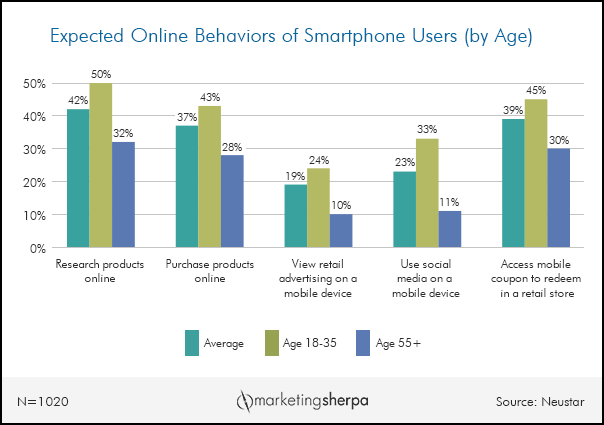
Men vs. women
While differences in age groups matter, gender is important to consider if your products or services are gender-specific. I'm afraid that the findings here are quite stereotypical. According to Payment Sense, "men are from Reddit, women are from Pinterest."
The same article found that men were more search driven than women and are likely to spend more. They also leave more reviews of products: 70% of top Amazon reviewers are male.
Women, on the other hand, are more sensitive to bargains, direct marketing, email, coupons, and will spend more time on social media researching products. They are also more likely to shop for a specific brand. Did I say stereotypical?
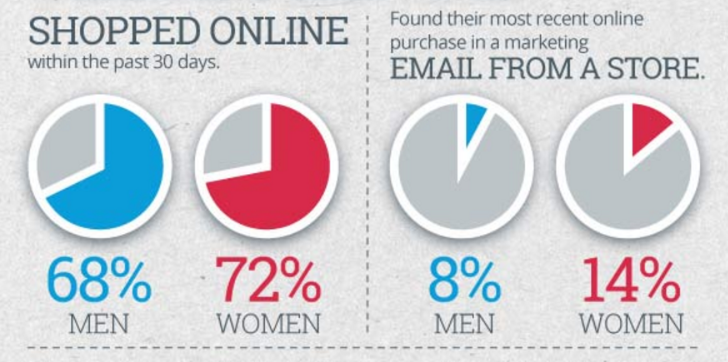
How do you get to know your users better?
Knowing these general facts and trends is important. However, what will give you a better sense for "your" prospects and customers is thorough user research.
There are many ways of gaining insight into customer behavior. Here in brief are some of the most important ones:
Analyzing the data
The most obvious one is to start by analyzing the data your users leave behind, leveraging Google Analytics or other tools that delve further into behavior tracking, such as ClickTale or CrazyEgg (find a list of some other ones on CMSwire).
Search queries will also give you good insight into what people are looking for and may not have been able to find by simply browsing.
Analysis of customer support calls can also yield valuable information about common questions or pain points.
Next to these traditional analytics, there is a trend to mine publicly available data. One example is slice.com, a service that offers users to track all their online purchases and receipts. In return, slice.com makes this data (anonymously) available to marketers.
Conducting online surveys
Online surveys are good for collecting bulk responses, general trends, and for comparison of results over time. They may not necessarily give insight into motivations and actual behavior, since they are self-reported and subjective.
Focus groups, interviews and contextual inquiries
Focus groups, interviews, and contextual inquiries are all direct qualitative methods which allow to dig deeper into the context and mindsets of the users. The trick here is to select a representative panel of users that are neither too enthusiastic nor overly negative to gain valid feedback.
While focus groups provide group perceptions and opinions towards design and features, interviews are usually conducted one on one and reveal more about the motivations of the individual user. Finally, contextual inquiries are unstructured interviews where the researcher observes the user in his environment. They are often more time consuming but can be invaluable when the audience operates in a very specific context.
Usability and A/B testing
Usability testing should be done at any stage of the (re)design project. At project outset, during the time of analysis and user research, it will show where the big issues and potential show stoppers are. Agile usability testing involves running frequent tests (daily, weekly, bi-weekly) with few people (even as little as 5).
A/B testing, which compares different versions of web pages or emails, has become very popular over the last few years. Not surprisingly, E-Commerce sites and apps are early adopters. Marketers can easily test content or layout modifications and optimize these to increase conversions. For some examples, check out the Guess the Test website.
Social media insights and feedback
Many researchers turn to social media to gather more insights and feedback. While social media is a great way to connect with your customer base and foster communities, it is also a biased medium, since it usually attracts those who are absolute fans or those who absolutely hate you. As a basis for objective customer research, social media should therefore be used with care and in moderation.
Bring user research to life using personas and user journeys
Once the data has been gathered and analyzed, it needs to be distilled and communicated to your marketing, sales, service, and development teams. Very helpful are so-called personas and user journeys, which portray typical user profiles, their background, context, needs and pain points. Used all along the design and development phases of a project and beyond, they help the team that builds and maintains the E-Commerce site to empathize with the users. Some useful tips on creating personas and user journeys can be found on UXMastery.
OK, now I know my users. How do I (re)design my online store for better customer experience?
There are a loads of UX guidelines and patterns you can follow. The challenge is to decide which ones are best for you. This is where consultants come in handy. 🙂
In the end, different market segments and business models necessitate a tailored approach. You cannot use the same content, functionality and UI patterns for a site that sells electric appliances as you would for an online grocery store. For obvious reasons, the former will probably offer more product information and customer hand-holding, while the latter will most likely require saved grocery lists and efficient add/remove from shopping cart features.
Niche sites, such as an origami paper distributor, may focus on creating a community around their offering in order to attract and retain their target audience, while shops with a broader product range may focus more on standard E-Commerce functionality, such as product comparison and customer support.
While E-Commerce is an area where UX patterns and best practices have been well established and standardized, there is also a lot of room for error, mostly due to lack of user research and attention to detail. Also, just because you can do something does not mean you should, and just because your neighbor has it does not necessarily mean you need it as well. However, it can't hurt to look over the garden fence now and then!
Further reading:
- The UX research firm Nielsen Norman Group has identified no less than 884 guidelines on what to do and not do for E-Commerce sites. Their report costs just under $500.
- Baymard Institute is another excellent source of independent research, featuring a large number of paid reports and free articles that address specific areas of E-Commerce usability.
- eConsultancy, cited earlier in this article, is a great place to find market research on E-Commerce and a wide spectrum of digital topics.
- For 105 free tips on E-Commerce and UX, check out selfstartr https://selfstartr.com/ecommerce-user-experience/

